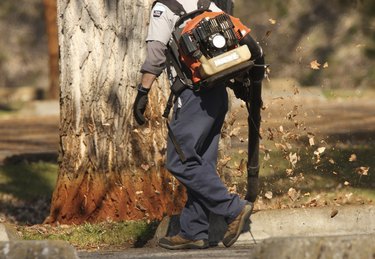
Whether you have a handheld or backpack Echo model, you can clean up the lawn much more quickly with a leaf blower than with a rake. But if you don't practice routine maintenance on the tool, it might not last as long as you'd like. Tuning up an Echo leaf blower does take some time, but once you master the steps, you can make sure it'll always be ready when you need it.
Practice Daily Checkups
Video of the Day
Some parts of an Echo leaf blower require regular monitoring. Typically, these areas should be cleaned and inspected before you use the blower each time. Start with the choke shutter, which moves the choke from the closed position to the open position. Examine it to ensure that the shutter is clean so it won't become stuck during use. You should also inspect and clean the cooling system prior to each use. Remove any debris from the intake grill between the backpack frame and blower housing in backpack models and the crankcase intake grill above the fuel tank in handheld models. Remove the spark plug lead from the spark plug so you can remove the plug and the engine cover. Clean the cylinder fins of any dirt or debris to keep air moving freely. Reassemble the blower's parts in reverse order.
Video of the Day
Keep Filters Clean
The air and fuel filters on an Echo leaf blower are key components to look at during a tune-up. Inspect and clean the air filter, if necessary, before each use. To clean it, close the blower's choke to prevent the carburetor throat from getting dirty when the filter is removed. Remove the filter cover, air filter, retainer and foam pre-filter; wipe away any dirt from inside the cover. Clean the pre-filter with detergent mixed with water and rinse thoroughly. Allow it to dry completely before reinserting it. Brush any dirt or debris away from the filter and reassemble. Replace the air filter every three months or when you notice damage such as extreme dirt on the surface or the rubber sealing edges becoming warped. Examine the leaf blower's fuel filter every three months when the fuel tank is empty. With a clean cloth, wipe away any dirt or debris around the fuel cap and the empty tank. Replace the fuel filter once a year -- with the "fuel line hook" from the Echo Repower Air and Filter Kit, pull the fuel line and filter free from the tank and replace it with a fresh filter.
Inspect the Spark Plug
You should examine, clean and replace the leaf blower's spark plug if necessary every three months. Remove the spark plug, located at the top the blower, and inspect it for any signs of wear or fouling. If the spark plug is dirty, use a clean rag to wipe away dirt and debris. Replace the plug if there are signs of damage or dirt that cannot be wiped away -- check the owner's manual to see what type of spark plug to use. Most Echo leaf blowers require an NGK BPM8Y spark plug. Bend the outer electrode to adjust the spark plug gap, and tighten it according to the instructions for the appropriate model.
Examine the Muffler
Examine and clean the leaf blower's muffler spark arrestor every three months to ensure that carbon deposits aren't causing a decrease in engine output or the engine to overheat. The spark arrestor screen typically requires replacement every three months. Start by removing the spark plug lead from the spark plug so you can remove the engine cover. Next, remove the exhaust deflector, spark arrestor cover, gasket and spark arrestor screen. Wipe away dirt or debris from the muffler components with a clean rag. Install the new spark arrestor screen and reassemble the gasket, plate, deflector and cover. Once all of the screws are tightened, attach the spark plug lead to the spark plug to reassemble.